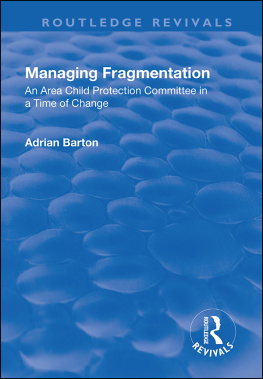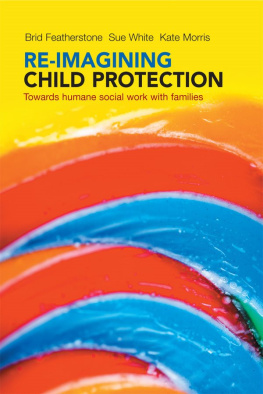THE MANAGEMENT OF CHILD PROTECTION SERVICES
To Sue, Feni and Tecka
First published 1999 by Ashgate Publishing
Reissued 2018 by Routledge
2 Park Square, Milton Park, Abingdon, Oxon OX14 4RN
52 Vanderbilt Avenue, New York, NY I 0017
Routledge is an imprint of the Taylor & Francis Group, an informa business
Copyright Robert Sanders 1999
All rights reserved. No part of this book may be reprinted or reproduced or utilised in any form or by any electronic, mechanical, or other means, now known or hereafter invented, including photocopying and recording, or in any information storage or retrieval system, without permission in writing from the publishers.
Notice:
Product or corporate names may be trademarks or registered trademarks, and are used only for identification and explanation without intent to infringe.
Publishers Note
The publisher has gone to great lengths to ensure the quality of this reprint but points out that some imperfections in the original copies may be apparent.
Disclaimer
The publisher has made every effort to trace copyright holders and welcomes correspondence from those they have been unable to contact.
A Library of Congress record exists under LC control number : 98040537
ISBN 13: 978-1-138-33819-7 (hbk)
ISBN 13: 978-0-429-44186-8 (ebk)
I would like to thank my colleague Sonia Jackson with whom I have collaborated closely over the last five years and who has helped me immensely in my learning about and writing about the management and policy of child protection. I would like to thank her as well for her observations on this particular text. I would also like to express my gratitude to those colleagues and friends who have assisted me by engaging in dialogue, providing me with material (in some cases on a very long-term loan basis) and for giving me encouragement and support. In particular I would like to express my gratitude to Rhona Hunt and Dr Alison Maddocks, for their contributions to my understanding of some of the issues involved in the organisation of child psychiatric services and the role of paediatricians in child protection respectively. As is customary, when acknowledging the help of others, I must emphasise that any mistakes, omissions, out-of-date material, etc., are entirely my own responsibility.
The University of Wales Swansea has provided me with considerable support, not least a period of study leave in Spring 1997, during which the majority of the material for this book was put together. Finally I would like to acknowledge the forbearance of my family who coped well with a largely absent member of the family.
Material from The Care of Children: Principles and Practice in Regulations and Guidance is reprinted with permission from The Stationery Office.
Frequent reference is made to Government guidance on child protection. To make the text flow more smoothly the two main publications will be abbreviated in the text. The earlier work, Department of Health and Social Security and the Welsh Office (1988) Working Together: A guide to arrangements for inter-agency co-operation for the protection of children from abuse, London: HMSO, will simply be referred to as Working Together (1988).
The latter volume, Home Office, Department of Health, Department of Education and Science, and Welsh Office (1991) Working Together Under the Children Act 1989: A guide to inter-agency co-operation for the protection of children from abuse, London: HMSO, will be referred to as Working Together (1991).
This book is not about child abuse; it is about child protection. The main aim of this book is simple: to inform the reader about the kinds of forces that have shaped current child protection practice in the UK and, to a lesser extent, in the rest of the world. It is about change and it is about systems. One cannot change what one does not understand. It is all too easy to enter a system, become familiar with its internal operations, and believe that on that basis change can be achieved. But systems operate within systems, and those external systems, whether temporal, spatial, or social, operate to keep the system stable - that is, change resistant (homeostatic). As an example, with my colleagues, I have described some of the difficulties facing ACPCs as national problems not local ones, but having local effects:
ACPCs are finding it frustrating trying to resolve at local level issues that are essentially national in character. One example of this is the participation of general practitioners in ACPCs and child protection case conferences. Another example would be developing policy with Education on the issue of abuse by professionals. These are not local issues, although they become local problems. There is a sense in which ACPCs are being used as a stage upon which are set issues and dilemmas, the resolution of which actually lies somewhere offstage.
(Jackson et al. 1994: 35)
This is essentially a systems-within-systems issue. One of the aims of this book is to help child protection professionals to better understand the roles and responsibilities of other agencies in contributing to the collective process of managing child protection services. If you the reader were to pick up this book for a browse and begin by looking at what it says about your particular agency, you may not find anything that is particularly new to you. But you may find the material on other agencies of use. Therefore, the book could be said to contribute to what has now become an accepted bedrock principle of child protection: children are best protected when agencies work well together; children are more at risk and less well protected when agencies fail to resolve their obstacles to working collectively. Those obstacles are frequently related to a lack of understanding.
This book is more about the management of child protection services than about the practice of protecting children. I plan to look at issues and dilemmas for agencies when working with other agencies to provide an interagency service. I will describe the managerial context of the different agencies, hopefully highlighting differences and similarities which when better understood should contribute to better communication between agencies.
This book was begun at a particularly exciting and challenging time in the management of child protection services in England and Wales. The preceding five years have seen significant effort on the part of all child welfare agencies being devoted to the establishment of new systems of child protection to take into account massive changes brought about by the implementation, in October 1991, of the Children Act 1989. The introduction of the Act represented a complete reform and rationalisation of the legal framework dealing with children and required fundamental shifts in attitudes towards work with children and families. Research during the 1980s, for example, as contained in the government publication Social Work Decisions in Child Care: Recent Research Findings and their Implications (DHSS 1985b) highlighted serious shortcomings in the child care system. For example, that admission to care and subsequent care careers were poorly managed, that compulsory powers were over-used, that parents of children in the care system felt pushed aside, and subsequently therefore lost contact with children, were all key issues that were addressed by the Children Act 1989.







